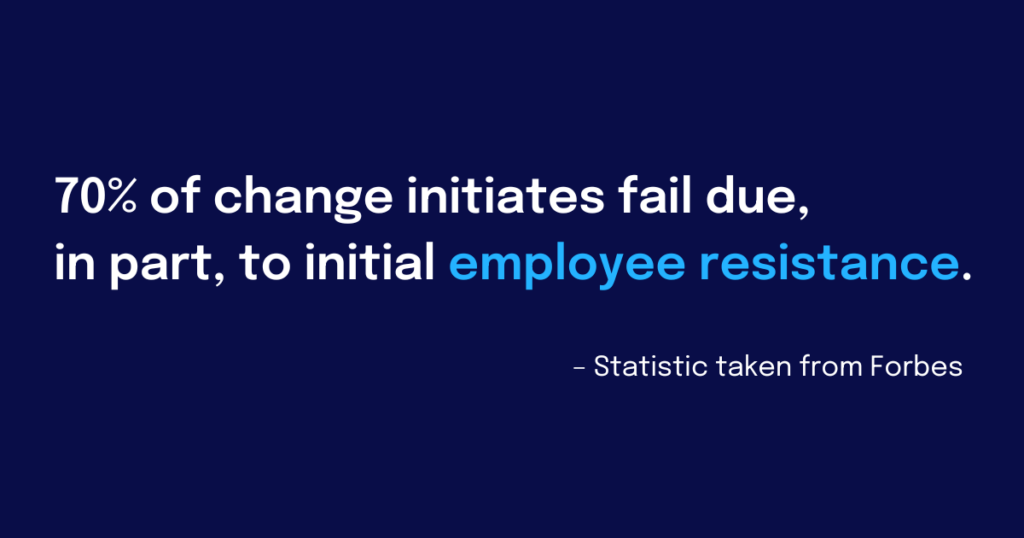12 Effective Change Management Strategies for Developing Organizational Change Management
Learn all about creating change management strategies, including exploring optimized change management strategy examples, best practices, and templates.

“If you want to make enemies, try to change something,” former US president Woodrow Wilson once said. It’s no secret that change management announcements can be met with apprehension, uncertainty, and even fear from workers. That’s why it’s paramount to create change management strategies that build trust among the workforce through the successful implementation of communications plans.
The following article outlines everything you need to know about creating effective strategies for change management to meet both short-term and long-term goals. Discover how to maintain employee morale, appeal to key stakeholders, and address potential resistance by building effective change management strategies to guide a workforce through transitional periods — and keep everything intact.
Defining change management
The first step to understanding strategy is defining change management. So, the definition of change management is pretty straightforward — this term refers to how businesses and organizations manage change and development.
Change management or change communication teams are crucial for ensuring a smooth transition during organizational transformations. And they are needed now perhaps more than ever, as changes are increasingly prevalent. A recent Gartner study revealed that the average organization today has undertaken five major firmwide changes in the past three years, with nearly 75% expected to multiply the types of major change in the next three.
Meanwhile, the Harvard Business Review outlined in a 2023 piece that 75% of organizations implement a top-down approach to change. This means that leaders ultimately establish change strategies, the detailed implementation of the plans, and the distribution of the majority of change communications.
What is a change management strategy?
Before we address how to create a change management communication strategy for your organization, we should define what is a change management strategy. Once again, this term isn’t trying to trick anyone: A change management strategy is a detailed plan for managing change.
Change management strategies ensure an understanding of the planned changes and their intended benefits. This can save time and money while keeping morale high and protecting employee retention during vulnerable periods of transition. This management plan incorporates strategies for change management to keep business environments operating at top capacity.
Change management strategies consist of a number of key elements but overall focus on making change accessible, understandable, and fully communicated to everyone involved and affected. Additionally, they allow employees to not only be empowered with information but also see how their feedback is valued. (More on this later.) So what’s the problem with change management?

Forbes discovered that one of the reasons why 70% of change initiates fail is due to initial employee resistance. The full cooperation of an organization is ultimately needed to navigate successful change management initiatives. Therefore, the strategies outlined and detailed in this article are designed to include the entirety of the organization in the change process.
Consider change management strategies the all-encompassing answer for empowering your management team, your employees, and the entirety of your workforce — including stakeholders.
Why you should invest in an organizational change management strategy
Changes are booming in organizations. PWC Global Workforce Hopes and Fears Survey 2024 survey found that nearly two-thirds of employees experienced more change at work in the last year compared to the previous 12 months. Plus, one-third of workers reported experiencing four or more significant changes at work, including changes to team structures and daily responsibilities.
What does this mean? Having an organizational change management strategy in place is essential. By integrating strategy and change management, companies can align their long-term goals with the necessary steps to achieve them. This will improve employee retention through increased company culture and contribute overall to heightened employee engagement, loyalty, and satisfaction.
Now, let’s look at some change management statistics from a Gartner report on change management strategies to understand the significance of creating an organizational change management strategy. Here are some statistics to consider:
First, change success increases by 24% when employees primarily own the implementation planning.
Meanwhile, involving employees in decision-making increases change success by an estimated 15%.
Lastly, organizations are 14x more likely to achieve change success if they implement open-source change management strategies.
Once again, this stresses the need for employee involvement with change management strategies. On the other hand, change exhaustion and burnout from failed change management models are very much real.
Unfortunately, change burnout was already high before the pandemic. However, many more employees have only become increasingly overwhelmed by poorly managed organizational changes in the past half-decade. This means it’s time to steer things in the right direction with new management plans.
12 effective change management strategies

For more questions and answers about change management, we recommend viadoo’s Knowledge Base. But now let’s discover how to compile change management strategies that address both short-term and long-term company goals. Understand the different elements that go into developing a change management strategy to create the most successful change management plans for your company.
1. Create a change communications plan
First, creating a detailed change communications plan that outlines the key elements of your change management strategy is a long-term goal that supports the entire change management process. This management plan is one strategy that should therefore be integrated into all business processes.
Develop a comprehensive communications plan to keep all managers, workers, and stakeholders informed about the change process. This includes regular updates, newsletters, and emails to ensure transparency and manage expectations. (More on communications channels soon!)
Clearly articulate the vision, objectives, and benefits of the change in the plan. Ensure that all employees understand how the change aligns with the organization’s overall goals. Additionally, include the rationale for why the changes will be made. Lastly, assess the impact on all business environments (including stakeholders) and be transparent and realistic about altered roles and responsibilities.
2. Create two-way communication channels
Encourage both open dialogue and a flow of information by establishing two-way communication channels. These allow employees to voice their concerns and suggestions, fostering a culture of collaboration. Communication channels also provide a clear and reliable flow of information.
What are some communication channels that align with effective change management strategies? Inform employees of change strategies and updates to the process on employee apps and company intranet platforms. You can also add to the flow of communication with internal newsletters, email updates, or analog options such as posters and brochures.
3. Invest in training & development programs
Another long-term change management strategy is investing in training and development. Offer targeted training sessions to equip employees and imbue them with the necessary skills and knowledge to adapt to the changes. Continuous learning opportunities can help ease the transition and also alleviate uncertainty.
Focus on enhancing skills and providing tools to empower and educate the workforce. This aligns with overall ownership values. Additionally, provide support structures such as coaching, mentoring, and counseling to help employees navigate changes. Access to resources and guidance also helps with combatting resistance. Remember, it’s paramount to success that employees are on board with changes.
4. Improve leadership communications
There are also specific steps change management teams can take to train leaders. According to insights from WTW, only around a quarter of employees say that change management is a strength of their organization’s senior leads. Therefore, there is a lot of room for improvement — especially while communicating as a leader contributes a crucial role to team success.
Ensure leaders are actively involved in communicating the vision and benefits of the change. Regular town halls, as well as video messages and Q&A sessions with executives, reinforce commitment and address concerns. Effective communication in leadership will rally a team, boost morale, and also ensure that employees are aligned with intended changes.
5. Offer pulse surveys
Another way to improve managing organizational changes in both the short-term and long-term is to create pulse surveys. Organizational change management strategies include the implementation of short, frequent surveys that gather feedback. Pulse surveys are intended to gather quick insights on specific issues. Therefore, they are brief and simple and are offered regularly.
Pulse surveys enable fast responses, which allow for timely interventions. The successful implementation of a change management strategy relies on employee feedback in real time. Therefore, keeping a pulse on the employee experience is vital. Because they are quick, pulse surveys are ideal for monitoring ongoing initiatives, assessing immediate reactions, and addressing current concerns.
Pro tip: Check out some employee pulse survey questions to help with creating your change management strategy.
6. Provide employee engagement surveys
In addition to pulse surveys, offer employee engagement surveys. This form of employee feedback is more comprehensive than pulse surveys and is thus offered with less frequency. Employee engagement surveys cover a wider range of topics and can focus on the entire change management process rather than a specific aspect of it.
While pulse surveys can be offered throughout the process, employee engagement surveys can be sent at the start and/or conclusion to compare responses and analyze changes in satisfaction. They offer a thorough analysis of a comprehensive range of topics. While employee engagement surveys are extremely important, they should be offered infrequently as a strategic move. This ensures maximum employee participation.
7. Establish feedback loops
In addition to surveys, establish formal mechanisms for employees to provide feedback throughout the change process. Regular check-ins, suggestion boxes, and open forums help gather valuable insights. While surveys encourage participation and direct attention toward specific issues at regular intervals, feedback loops allow employees to weigh in during the entire change process.
Successful change management plans also demonstrate to employees how their feedback is valued. Doon’t just ask for feedback — take it to heart. Show your employees how their feedback affects the change management process. All effective communication plans incorporate employee opinions.
8. Analyze stakeholder involvement
Your change management communication strategy should also encompass communication with key stakeholders. First, map out all stakeholders and analyze their influence and interest in the change. This prioritizes communication efforts and allows you to additionally address the needs of key stakeholder groups effectively.
Be sure that key stakeholders, as well as employees, are provided with critical information about the change. Demonstrate a clear and compelling vision for the future post-change and highlight how the changes will drive growth and create value. Remember, investors are particularly interested in understanding how the change will positively impact the organization’s performance and profitability.
9. Create an employee ambassador program
Another way to reduce resistance and get employees on board is to appeal to them through an employee ambassador program. Developing a change management strategy should therefore involve the inclusion of the workforce. Identify and empower a group of enthusiastic employees to act as change champions. They can advocate for the change, provide peer support, and gather grassroots feedback.
Employee ambassador programs facilitate the spread of key messages within a company through a strategic communications plan. People want to hear from people. Therefore, having coworkers share news increases the chance of it being heard and drives engagement. Overall, this increases company culture and creates an environment where coworkers build credibility, leadership, and ownership.
10. Conduct regular impact assessment
Another example of good change management strategies involves regularly conducting impact assessments. Conducting regular impact assessments allows the change management team to understand how the change is affecting different parts of the organization. Therefore, this helps in identifying and addressing any unintended consequences.
Conducting impact assessments highlights which areas of the change management are effective and which organizational changes need refinement. Management teams should take careful note of feedback, as this once again provides the opportunity to amend the change management strategy and respond to potential resistance. Ensure that alterations are communicated with the workforce so workers know their feedback is valued.
11. Consider pilot programs
A short-term change management strategy to support long-term goals is implementing pilot programs. Some effective change management strategies rely on these programs to ease major changes for workers. By introducing changes on a smaller scale first, organizations can observe the impact and additionally gather feedback in a controlled environment. This method helps identify potential issues and allows for adjustments before a full-scale rollout.
Pilot programs also help to mitigate risks associated with change, providing a safer way to innovate and adapt. Implementing pilot programs to test changes ensures smoother transitions. Meanwhile, employees involved in pilot programs can become change advocates, sharing their positive experiences to ease concerns among their peers. Additionally, pilot programs provide concrete data on the effectiveness of changes. This ultimately builds a stronger case for broader implementation.
12. Acknowledge milestones
Lastly, celebrating milestones and successes throughout the change process is crucial for maintaining momentum and boosting morale. Recognizing achievements, no matter how small, helps to keep employees motivated and engaged. It reinforces the progress being made and shows that the organization values its employees’ efforts. Publicly acknowledging milestones fosters a sense of accomplishment and overall encourages continued commitment to the change initiative.
Incorporating regular celebrations of milestones into the change management strategy also helps build a positive culture around the change process. It creates opportunities for employees to reflect on their contributions and see the tangible results of their hard work. This recognition not only boosts individual morale but also strengthens team cohesion and collaboration. By making milestone celebrations a regular part of the change journey, organizations can sustain enthusiasm and drive successful outcomes.
Sample change management strategies
Now that we’ve discovered strategies for change management, it’s time to explore some of the successful change management strategies in action. Let’s briefly examine some change management strategy examples that work, as well as steps to take to implement them.
1. Establish cross-functional teams
Form cross-functional teams to bring diverse perspectives from different departments and ensure all aspects of the change are considered. This approach fosters collaboration, breaks down silos, and encourages a holistic view of the change process. It also helps identify resistance and develop a detailed plan to address it.
Step 1: Identify key departments and select representatives from each to form a cross-functional team.
Step 2: Define clear roles and responsibilities for each team member to ensure diverse perspectives are considered.
Step 3: Schedule regular meetings to discuss progress, challenges, and solutions related to the change initiative.
Step 4: Use collaborative tools like employee apps to facilitate communication and track progress.
Step 5: Develop a detailed plan that outlines potential resistance and strategies to address it.
2. Use change champions
Identify and empower change champions within the organization to advocate for the change, provide peer support, and gather feedback. Change champions also build trust and credibility to make transitions smoother and more accepted.
Step 1: Identify influential and respected employees across different departments to act as change champions.
Step 2: Provide training to change champions on the change initiative, its benefits, and their role in the process.
Step 3: Encourage change champions to gather feedback from their peers and communicate it to the leadership team.
Step 4: Organize regular check-ins with change champions to discuss progress and address any concerns.
Step 5: Recognize and reward the efforts of change champions to maintain their motivation and support.
3. Implement agile methodologies
Adopt agile methodologies for change management. This involves breaking down the change process into smaller phases and iterating based on feedback. Agile methodologies allow for flexibility and quick adjustments, ensuring the change process remains dynamic and responsive.
Step 1: Break down the change initiative into smaller, manageable phases or sprints.
Step 2: Assign specific tasks and goals for each phase, ensuring clear timelines and responsibilities.
Step 3: Conduct regular sprint reviews and retrospectives to assess progress and gather feedback.
Step 4: Iterate based on feedback, making necessary adjustments to improve the change process.
Step 5: Use agile project management tools to track progress and facilitate collaboration.
4. Develop resilience training programs
Offer resilience training programs to help employees cope with change. These programs focus on building mental toughness, adaptability, and stress management skills. Overall, they reduce resistance and increase resilience to change.
Step 1: Assess the current resilience and stress management skills of employees through surveys or assessments.
Step 2: Design a resilience training program that includes workshops, seminars, and e-learning modules.
Step 3: Incorporate topics such as mental toughness, adaptability, and stress management techniques.
Step 4: Provide access to support resources like coaching, mentoring, and counseling services.
Step 5: Evaluate the effectiveness of the training program through feedback and performance metrics.
Overall, these strategies provide a robust framework for managing organizational change effectively, ensuring a successful transition for both the organization and its employees. Each sample change management strategy can be tailored to fit specific organizational needs and objectives, creating a comprehensive and adaptable change management plan.
Change management strategy template
Additionally, creating a comprehensive change management strategy is essential for guiding an organization through periods of transition. The following change management strategy template outlines the key steps involved in developing a successful change management plan.
Change management strategies areas to improve

Before we conclude our conversation, there is a final point to address. As we touched upon at the start, many change communication strategies fail. Therefore, teams should focus on key areas of their plans to avoid this outcome. The PWC Global Workforce Hopes and Fears Survey 2024 identifies several crucial factors for successful change management strategies: These include:
1. Leadership and communication
Effective leadership is paramount in any change management strategy. Leaders must engage employees through a clear communication strategy, detailing the reasons for change, the actions being taken, and the impacts on roles and jobs. Transparent communication from all levels of leadership, particularly CEOs, builds trust and is essential for gaining employee buy-in.
2. Employee engagement and support
Involve employees in the change process. Provide opportunities for them to propose and test new ideas. Ensure they understand how changes align with the company’s strategy. Address employee stress and workload. Additionally, prioritize well-being and create a supportive company culture that encourages maintaining work-life balance.
3. Skill development and upskilling
Providing opportunities for skill development is a major factor in retaining employees and ensuring they can adapt to changes. Companies need to develop a culture of continuous learning and ensure that upskilling programs reach all employees, not just those in specialist roles. This is key to compliance, loyalty, and combatting resistance.
4. Responsible use of technology
The integration of technologies such as Generative AI should be done responsibly. Employees need to feel confident that AI tools are used ethically and effectively. Provide training on AI use, be transparent, and establish governance frameworks to manage organizational change involving new technologies.
Concluding words on change management strategies
Overall, effective change management strategies that focus on vision, alignment, resources, planning, skill, incentive, and communication are essential for ensuring the smooth and effective implementation of organizational change. Without change management strategies, disruption, chaos, and uncertainty can plague an organization and lead to higher levels of employee dissatisfaction.
Remember that above all, organizational change management strategies rely on effective communication. However, communication is only impactful if it is provided to everyone in an organization. Ensure that all employees have equal access to change management strategy updates, info, and feedback forms by keeping them in the loop on your employee app.









